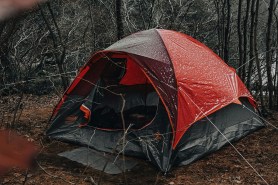

Tent pegs are one of the smallest and sometimes most overlooked pieces of camping equipment that is vital to the entire operation.
Videos by Outdoors
A tent will not stay up by itself, after all. It needs to be securely attached to the ground, and it must also have secure guy ropes. The ropes hold up the tent, and the pegs anchor the ropes to the ground.
If a peg fails, it can lead to utter misery, as Bear Grylls recounts when he tells the story of a disastrous camping experience on his first ever mountaineering trip in his book Mud Sweat and Tears.
An Expensive Lesson

During his school days, Bear went camping in Mount Snowdon in Wales with his school friend Watty. Their backpacks were so heavy that they didn’t reach where they were going to camp until after midnight, and it was raining hard. Bear says that they put up their tents and did everything in a rush as they were so tired and wet, and they cut some corners.
At 3 AM, one of the pegs supporting the tent broke. Bear says that he assured himself that the other pegs were still in place, so he didn’t take action.
“Both Watty and I were just too tired to get out and repair the first break, and instead we blindly hoped it would somehow just sort itself out,” says Bear in Mud Sweat and Tears. “Tents don’t repair themselves, however tired you are, however much you wish they just would. Inevitably, the next peg broke, and before we knew it we were lying in a wet puddle of canvas, drenched to the skin, shivering, and truly miserable.”
When tension was lost from the first break, the rest of the tent was taking too much strain, so the remaining pegs gave way.
“The key lesson learnt that night was that when it comes to camping, a stitch in time saves nine; and time spent preparing a good camp is never wasted,” says Bear, who later wrote about the incident in Survival Guide for Life, saying that he “learnt a very valuable lesson about tents, and about life, too.”
Types of Tent Pegs
Using the pegs that came with your tent makes sense, but did you know there are many different types of pegs that suit various conditions, and there are different ways to use them, depending on the ground conditions?
Bear Grylls lists the different types of pegs in Ultimate Survival Handbook. These include standard tent pegs, steel tent pegs, aluminum pegs, plastic pegs, wooden stakes, plastic twists, glow-in-the-dark pegs, aluminum pegs for sand, plastic pegs for sand, delta pegs, and sand anchors. Also useful is a peg puller tool and a mallet, which has a hook at the other end for removing pegs.
Placing Pegs

“It is important to make sure your tent is stable and stays put so that you have proper shelter,” says Bear.
Always make sure that the rope is at a 90-degree angle to the peg. If you need more stability, use two pegs for extra security. Delta pegs make the hold very secure.
If you need extra back up, use a heavy rock to secure a peg if it will not go into the ground, or use piles of rocks to anchor your lines.
One of Bear’s favorite ways to anchor a tent peg in a mountain setting is to put the peg into a sleeping bag case, fill the case with snow, and then bury it.
In ice, you can place a tent peg into a hole in the ice for stability. You can also bury the peg in ice so that it freezes there and secures its hold.
In the desert, bury the peg in sand to make a good anchor. Or, you can place heavy objects into a parachute anchor, add the peg, and then bury it.
What’s your favorite type of tent peg, and why?









